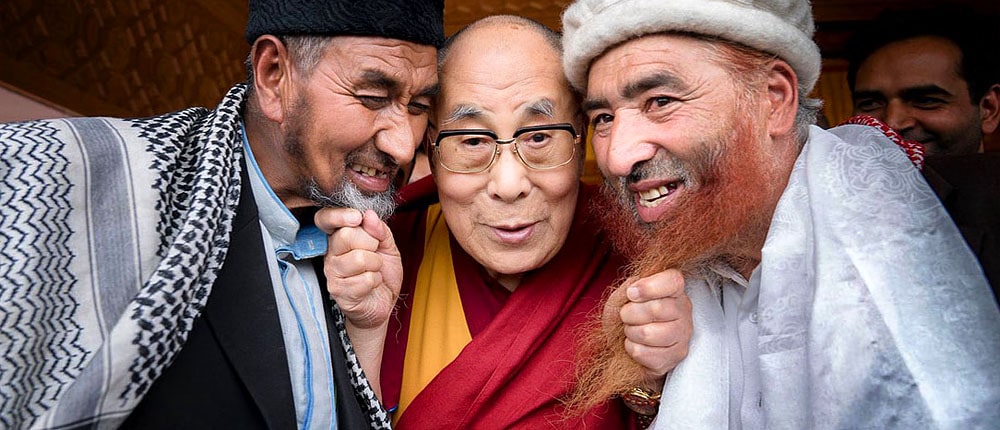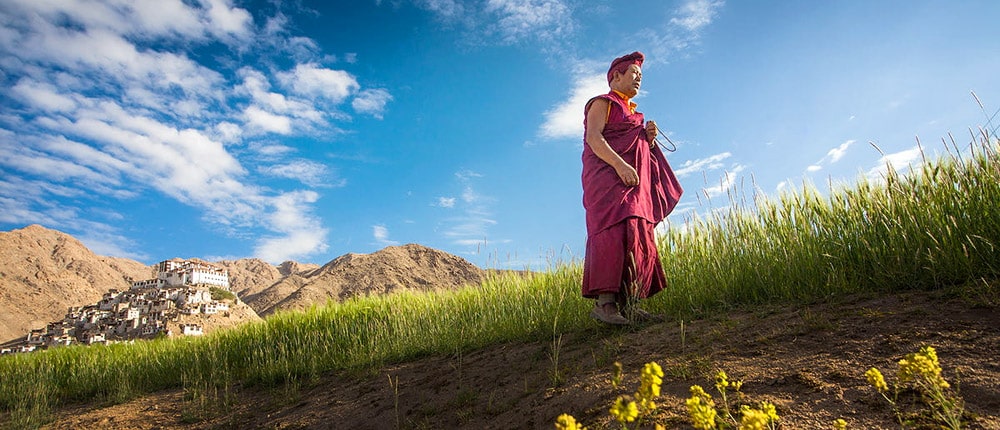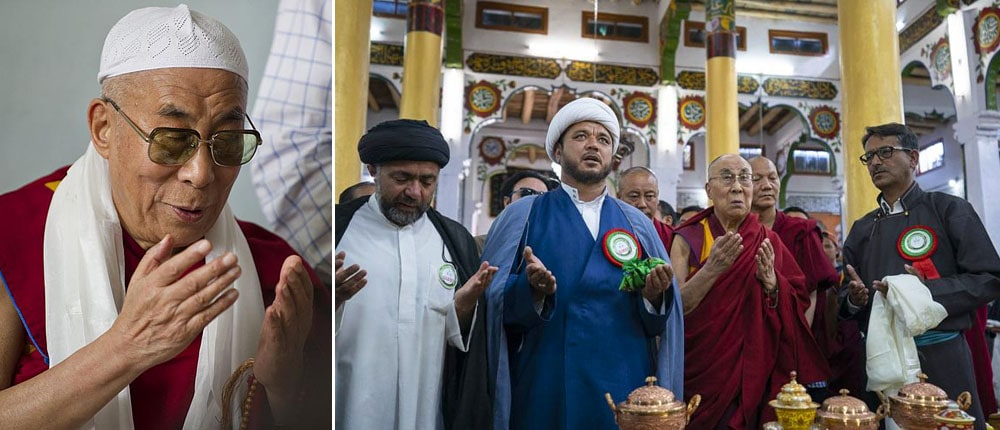Buddhism and Islam are the two main religions of Ladakh. Leh is dominated by Buddhists while Kargil is mainly composed of Shiite Muslims. There is also a small population of Sunni Muslims in addition to Hindus, Sikhs and Ladakhi Christians.

History of Religion in Ladakh
Nature Worshipping
The earliest settlers in Ladakh were Aryans who ascribed divine power to nature and worshipped its many facets. It was similar to that of Vedic religions of the Indian Subcontinent.
Shamanism
After the period of nature worship, Shamanism or Bon religion took hold in Ladakh. Like nature worship before it, it had a pantheon of gods and goddesses. In Ladakh, the present-day Lamayuru Monastery was the seat of power of the faith.
First Forays of Buddhism
Emperor Ashoka sent missionaries to Ladakh to convert the feuding populace to Buddhism with mixed results. Buddhism took hold in Ladakh only when the Kushans conquered the region in 1st - 2nd century AD. The most visible symbol being the Kanika Stupa in the Zanskar Valley. However, Buddhism did not survive for long in Ladakh after the fall of the Kushans.
Initial Flourishing of Buddhism
When Ladakh became part of the Tibetan Empire in the 7th century, the Tibetan emperor Songstan Gampo initiated a period of Buddhist proselytization in his domains which was continued by Emperors Trisong Detsan and Tri Ralpachan. Buddhism enjoyed a brief golden age during the 8th century, before being snuffed out by the policies of Emperor Langdarma and the subsequent decline and the fall into civil war of the Tibetan polity. Ladakh, in the meantime, was dominated by warring princes.
The Second Spread of Buddhism
In the 11th century, the younger grandson of King Skyid Lde Nyima of Ladakh, King Yeshes Od of Guge resurrected Buddhism in Tibet, also known as the Second Diffusion of Buddhism. A number of Buddhist monasteries were established across Ladakh in the process. The building of these monasteries is credited to Rinchen Zangpo, a scholar, in the service of the King of Guge. However, recent research proves otherwise. Among these monasteries, Alchi Choskor is famous for its paintings the world over. The chief among them, Nyarma Monastery, was plundered and destroyed by Turkic invaders under Mirza Haider in 16th century.
Beginning of the Establishment of the Great Monasteries
In 12th century, the forerunners of several major monasteries were founded. These early monasteries belonged to the ancient Kadampa sect. These included Likir monastery, Thiksey monastery and Spituk monastery. Under King Lhachen Ngosdup Gon, novice monks were sent to Tibet to obtain education in Buddhist philosophy.
Buddhist Hegemony in Ladakh
Up until mid15th century, Buddhism flourished virtually unchallenged in Ladakh. The major figure of the age was Changsems Shesrab Zangpo, one of the chief exponents of the Gelugspa or the Reformed Sect who founded the monastery at Stakmo. His disciple, Paldan Shesrab founded the Thiksey monastery on the site of a Kadampa establishment, which, later on, rose to become the dominant monastery of the sect in the kingdom.
Advent of Islam in Ladakh
In 1382 CE, Mir Syed Ali Hamdani came to Ladakh and carried out the first conversions to Islam. He is said to have built the Shey mosque. Later on, in 15th century, Shamsuddin Iraqi came to Ladakh and converted a small section of the population to the Noorbakshi sect of Islam. The early Muslims were traders from Kashmir who settled down in Ladakh and married Ladakhi girls.
Conversion of Western Ladakh to Islam
In the mid-16th century, most of Western Ladakh converted to Shia sect of Islam.
The Ill-fated invasion of Baltistan and its aftermath
King Jamyang Namgyal, who reigned from 1595 to 1616, launched an invasion of Baltistan to pacify the region, but was instead defeated and got himself captured in the ensuing conflict. The conflict ended when the King married a Balti princess, Gyal Khatoon. She came to Ladakh with a large retinue who were then settled in Chuchot.
Staktsang Raspa and the rise to primacy of the Drukpa sect
In 17th century, Staktsang Raspa, an accomplished Tibetan master, visited Ladakh on the invitation of the King of Ladakh. King Singey Namgyal bestowed him with financial as well as political patronage. He established a series of monasteries across Ladakh, the most important of which was the Hemis monastery, founded in 1630, on a former royal estate given to Staktsang Raspa by the King.
The Ladakhi-Tibeto-Mongol-Mughal War and its religious ramifications
This was a war riddled with contradictions and the treaty which ended it, the Treaty of Tigmosgang, saw the Ladakhi Sovereign lose a great deal of independence, particularly regarding the religious policy within and outside his greatly reduced domains. The losses during the war of Ladakhi forces to the invading Tibeto-Mongol forces and the subsequent dependence on the neighbouring Mughal Empire’s assistance against the aforementioned invaders meant that at the end of the war, the Ladakhi king had to pander to the other parties’ will, which meant Tibetan interference in the religious policy of the kingdom.
Religion during the Dogra Period
The eclipse of royal power after the Dogra conquest and the parallel decline of the aristocracy contributed to the material decline of the monasteries as the lack of financial patronage by the now impoverished elite and the end of grants to the clergy hamstringed the expansion of the monasteries, and in most cases, led to their decline. The major monasteries during this period were materially supported by the major landed families, most of whom belonged to the aristocracy of the erstwhile Kingdom of Ladakh, in return for religious and social privileges.
Kushok Bakula and the Revival of Buddhism in Ladakh
The 19th Kushok Bakula was born in the Royal House of Matho in 1918. At the age of 3, he was recognized as the reincarnation of Arhat Bakula, one of the sixteen direct disciples of Lord Buddha. He obtained Geshes Lharampa degree from the Loseling Drepung Monastery in 1940. He returned to Ladakh the same year. Post-Independence Ladakh witnessed his emergence as the tallest leader of Ladakh. His social reforms included the abolition of animal sacrifice and attempts at reforming the caste system in Ladakh.

Buddhism in Ladakh
Major Sects
Drugpa Kagyu Sect
The Drugpa sect took hold in Ladakh with the arrival of Staktsang Raspa and its subsequent patronage by King Singey Namgyal and his successors but despite claims by Tibetan writers of discrimination against Gelugspa sect, the Ladakhi rulers were fairly tolerant of other sects as well as other faiths. The founding of the Hemis monastery, originally, a hermitage, in 1632, and its emergence as the seat of power of Staktsang Rinpoche, the Royal Preceptor of the Kingdom of Ladakh, inaugurated a period of architectural renaissance in Ladakh. Even now, thanks to its earlier pre-eminence, it has the largest following among other Buddhist sects.
Gelugspa sect
Ladakh witnessed the flowering of Gelugspa sect at around the same time as Tibet itself i.e. just before mid-15th century. Changsems Shesrab Zangpo, the chief disciple of Tsongkhapa, the founder of the sect, was responsible for laying the foundations of this sect in Ladakh. Monasteries belonging to this sect is spread all over Ladakh, the chief being Thiksey and Spituk monasteries. Rizong Sras Rinpoche is the only Ladakhi to ascend to the throne of Galdan, the most prestigious position within the sect.
Drigung Kagyu sect
Drigung Kagyu sect, established in 1179 in Tibet, saw its spread in Ladakh in the following century. But the major figure of the sect in Ladakh was Chosrje Danma Kunga Tagspa, who emerged in the 16th century. The main monasteries are Lamayuru, Phyang and Shachukul.
Saskya sect
Saskya sect has a small following in Ladakh. The main and the only monastery of the sect in Ladakh is the Matho monastery.
Nyingma sect
The Takthok monastery is the only monastery belonging to this sect in Ladakh.
Major Shrines
- Hemis Monastery
- Alchi Monastery
- Chemrey Monastery
- Thiksey Monastery
- Spituk Monastery
- Monastery Monastery
Traditions
In case of death, rituals are performed for a certain number of days as instructed by an astrologer, after which the body is cremated following elaborate rituals as per the respective traditions of the sect to which the family belongs.
Ceremonies
Every Buddhist house has usually a chapel which is the centre of periodic rituals performed by local monks. Each sect has its own certain rituals. One common ritual is Skangsol which is held in the autumn season to mark the harvesting of crops.
Festivals
As per the Buddhist Calendar, there are monastic festivals throughout the year. The biggest of them all is the Hemis Tsechu, celebrated at the Hemis monastery on 10th day of the 5th month of the Buddhist Calendar. Aside from the monastic festivals, the main festival celebrated by the Buddhists is Losar, the Ladakhi New Year which is held on the first three days of the 11th month of the Buddhist Calendar. In Leh, the celebration goes on until Dosmochey which is held in late winter.

Islam in Ladakh
Major Sects
Shia sect
The Shia sect of Islam is the most widespread sect of Islam in Ladakh. It forms the majority of the population of the Kargil district and also has sizable presence in Nubra valley as well as in Chuchot in Central Ladakh.
Sunni sect
This sect of Islam has a presence in both the districts of Ladakh. Most of the followers of this sect are descendants of Kashmiri traders who married Ladakhi girls and settled down in Ladakh itself. Their descendants are called Arghon.
Noorbakshi sect
The Noorbakshi sect owes its origins in Ladakh to Mir Shamsuddin Iraqi who came here in the 15th century.
Major Shrines
- Jama Masjid, Leh
- SH Hamdan Masjid, Shey
- Imam Bargah, Chuchot Yokma
- Masjid e Jafria, Drass
